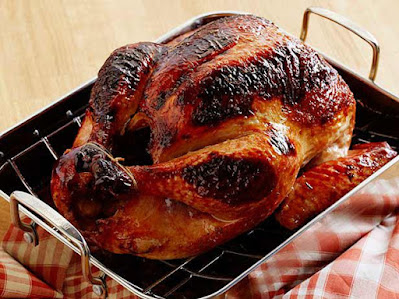Deep-Fried Turkey with Southern Rub
Deep-frying a turkey is an experience that can swiftly transform a skeptic into a believer the first time you taste it. Completed in just 40 minutes, it's incredibly juicy, not greasy at all, with skin that's unbelievably crispy. Rubbing the turkey and allowing it to absorb the flavors is crucial. We’ve compiled additional tips for deep-frying a turkey, along with a detailed guide on frying a turkey as well.
Search for a fresh turkey; they usually turn out crispier and more flavorful than those that were frozen before. If you have to use a frozen turkey, ensure it is fully thawed before frying (this will require a few days in the fridge). Filé consists of ground sassafras leaves, a favored spice in the South, particularly in Louisiana, where it serves as both a condiment and thickening agent for gumbo.
Here it gives a subtle earthy taste to the rub. Search for it in the dried herbs aisle of supermarkets. Peanut oil is ideal for frying due to its high smoke point and neutral taste. To determine the amount of oil needed, use this displacement method: Before unwrapping the turkey, put it in the frying pot and add sufficient water to fully immerse it. Take the turkey out of the pot and gauge the water: That’s the amount of oil you need to use.
Special gear:
A propane turkey fryer such as this model from Bayou Classic was all that was required to prepare a juicy, crispy turkey. It includes the base, pot, turkey rack, thermometer, and several accessories. We donned heat-resistant rubber gloves and safety goggles to shield our hands and eyes during frying. On that subject, it’s beneficial to keep a multi-use fire extinguisher available, just in case.
Plan:
Ensure you allocate sufficient time to thoroughly thaw your turkey, and then let your seasoned turkey rest overnight in the fridge for the flavors to fully infuse. Additionally, when frying, allow your oil ample time to reach the proper temperature. Each time we tested, it took about 40 minutes for ours to reach temperature. Make sure to carefully read the instruction manual that accompanies your fryer prior to using it!
For additional information, we suggest our simple guide on Smoking a Turkey.
Fixings
For the rub:
- 1/2 cup pressed dim earthy colored sugar
- 6 tablespoons dry mustard, like Colman's
- 6 tablespoons legitimate salt
- 2 teaspoons filé powder
- 2 teaspoons hot paprika
- 1/2 teaspoon newly ground dark pepper
- 1 (15-to 18-pound) new turkey
- Nut oil for browning (around 4 gallons)
Guidelines:
Make the rub:
Combine the focus on fixings a blending bowl and put away.
Rub and cook the turkey:
Eliminate the pack of giblets and the neck from inside the turkey. Save in the fridge until prepared to set up the sauce. Wash the turkey all around and wipe it off with paper towels. Trim the greater part of the abundance fat and skin from the neck and cavity (this takes into account better searing). Make a 3-inch-long cut on one or the other side of the turkey through the skin where the leg meets the bosom.
This will permit the oil to deplete away and the thigh meat to cook totally.Spaghetti-with-garlic-shrimp-broccoli.
Put the turkey on a cutting board or baking sheet and coat it equitably with the rub, including inside the depression. Place the turkey in a plastic sack and permit to rest in the fridge short-term.
Heat the oil in a turkey fryer until it registers 350°F. (This requires around 40 minutes.) Remove the turkey from the fridge and allow it to sit at room temperature for 30 minutes. Eliminate it from the sack and daintily blotch it with paper towels to eliminate overabundance dampness.
Put the turkey on the fricasseeing rack, drumsticks facing up like it's doing a headstand. Utilize the get snare to gradually bring down the turkey into the warmed oil; this requires somewhere around 90 seconds.
The oil will bubble angrily; this is ordinary. Wear heatproof gloves and security goggles, and don't drop the turkey.
When the turkey is totally lowered, eliminate the snare. Fry for around 3 minutes for every pound or until the juices run clear and a thermometer embedded into the inward piece of the thigh peruses 155°F.
Utilize the get snare to gradually eliminate the turkey from the oil, permitting adequate time for the hot oil to deplete away.
Put the turkey and rack on a rimmed baking sheet set on the ground, and allow them to sit a couple of moments prior to moving to permit any additional oil to deplete. Allow the turkey to rest for something like 15 minutes. Eliminate it from the rack and cut. Appreciate it !!!
Deep-Fried Turkey with Southern Rub VIDEO



